Climate Change Impacts on the Road Transport Infrastructure: A Systematic Review on Adaptation Measures
Abstract
1. Introduction
2. Materials and Methods
3. Bibliometric Results
4. Systematic Results
| Agents and Weather Condition | Possible Impacts to Road Infrastructure | Risk Identification Methods | Hard Adaptation |
|---|---|---|---|
| Temperature: High temperatures and heat waves; Daily temperature variation | Impacts on concrete pavement construction practices, including thermal expansion at bridge joints [1]. Pavements are vulnerable to reduced life with climate-change-induced temperature rise [39]. Higher temperatures reduce asphalt-layer stiffness and strength [40]. Concerns about pavement integrity, for example, relatively large deflections, transverse cracks, reduced asphalt pavement deformation rate, and permanent set [5,41]. Changes in landscape/biodiversity [1]. | Use of Geographic Information System (GIS) models to identify problem areas, based on performance criteria, considering two main factors: solar irradiance and pavement materials [42,43]. Use of unmanned aerial vehicle systems, sensors and photogrammetric processing techniques that allowed timely and highly detailed three-dimensional surface reconstructions [27]. A hybrid bottom-up/top-down approach can be used to quantify the impact of changing pavement seasons and temperatures on pavement life with incremental temperature rise [39]. The Long-Term Pavement Performance Model (LTPP) can be used to determine asphalt pavement surface temperatures in order to assess the relative impact on the appropriate Superpave Performance Grade for more durable and resilient pavement construction [44]. | Pavement irrigation is an emergency response to heat waves [43]. Use of hard bitumen to withstand heat in summer, flexible and solvent-workable bitumen in winter, soil moisture control and maintenance planning [45]. Use of cool pavements (they have lower surface temperature and are an important solution to mitigate the effects of sensible heat flow) [21,46]. Use of vegetation around highways (providing shade, releasing water vapor into the atmosphere and maintaining air quality) [21,46]. Asphalt materials with stronger binders can allow easy adaptation of pavement materials so that no change in the behavior of the bituminous pavement occurs [5]. |
| Temperature: Thawing/Thawing permafrost | Landfill instability caused by thawing [27]. Plastic deformation (sinking) of roads, bridge foundations (collapse), pipelines, and pavement layers [47]. Severe compromises of ice road infrastructure [48]. | Use of unmanned aerial vehicle systems, sensors and photogrammetric processing techniques that allowed timely and highly detailed three-dimensional surface reconstructions [27]. | Addition of gravel and coarse embankment to stabilize the road embankment [27]. Replace winter ice roads (built on vast fields of ice and snow instead of asphalt, concrete or crushed stones, etc.) with land roads [48]. |
| Temperature: Freezing/Thawing | Occurrence of differential freezing (slippery conditions form on the surface of isolated sections of pavement, while adjacent conventional sections of pavement maintain dry surface conditions) [49]. Premature deterioration of pavement structures, resulting in increased cracked area [50]. Avalanches and rockslides result in road blockages, interrupting access, and cause infrastructure damage [51]. Occurrences of slush flows with impact on infrastructure, through entrain varying quantities of mineralogical material, topsoil and trees due to intense snowmelt [52]. Deterioration of porous asphalt resulting in raveling, pothole damage and material loss at the longitudinal joints [53]. | Application of pavement design methods to identify problem areas and determine the granular layer thickness that avoids most situations of differential freezing [49]. Application of meteorological statistics from regions affected, with data from National Center for Atmospheric Research (NCAR) and Arctic Climate Impact Assessment (ACIA) as well as NOAA-CIRES, Climate Diagnostics Center [52]. Use of the Road Weather Information System (RWIS) for continuous monitoring and early warning of slippage on road pavements based on road surface temperature, strength (dry, wet or salt), dew point and precipitation [53]. | Road infrastructure with large thicknesses of crushed granular material, so that ice penetration never goes deep enough to cause elevation (and therefore allow further thaw) of the subgrade without compromising infrastructure [5]. Modification of the asphalt mix design or increasing pavement thickness [54]. |
| Precipitation: Intense Precipitation | Decreased pavement life due to premature damage to materials and structure [5,6,7]. Overloading drainage systems, causing backups and flooding of roads [1,5]. Mass movements of soil and rocks (slides) that damage roads [1,55]. Impacts on soil moisture levels, affecting the structural integrity of roads, bridges and tunnels [1,55]. Foundation damage of bridges and culverts due to abrasion [45]. Scour of piers/abutment foundations [55]. Possibility of delayed effect failure that occurs when no immediate damage is induced at the time of the flood, but deterioration is accelerated afterwards [7]. | Use of GIS to identify the area at risk of flooding, overlaying the flood-sensitive areas with the road network area, using the flood sensitivity data [56]. Determining the influence of landscape patterns (ie: composition and configuration) of the impermeable surface on flood risk points [57]. Data-driven spatio-statistical approach to quantify and map flood probability [58]. Integrated framework that couples simulations of flooding and transport to calculate the impacts of disruption [32]. | Permeable paving, improved drainage or raising the level of the link that reduce flooding [32,59]. Increased road surface curvature for rapid surface water removal, maintenance frequency, base and subbase design, and material selection [45]. Regarding bridges and culverts, there is a need to estimate flooding, return period, design flow, cleaning above the high level of flooding, river and bank protection and corrosion protection [45]. Large-scale adoption of nature-based solutions and other types of green infrastructure that allow water infiltration and decrease flow peaks [60]. Install geotextiles and geogrids to prevent cracking [55]. Development of Flood Emergency Management Systems [33]. |
| Precipitation: Low Precipitation-Drought Conditions | Ground stability impacts (desiccation, shrinkage of clay materials) [55]. Problems of instability in the infrastructure [61]. Increased susceptibility to wildfires that directly threaten transport infrastructure [1]. Greater susceptibility to landslides in areas deforested by forest fires [1]. Loss of soil cover, allowing for easier erosion when rain occurs, allowing soil fines to reach drainage systems [5]. | Droughts are typically associated with aridity. Therefore, to track predicted urban sprawl in drought-prone areas, one can use a dataset from the Global Aridity Index from the Consortium for Spatial Information of the Consultative Group on International Agricultural Research [62]. | Large-scale adoption of green infrastructure (or eco-efficient infrastructure) represents long-standing principles of durability, flexibility and energy efficiency in infrastructure construction [61]. The use of new, more permeable paving materials with the potential for water storage can help reduce the severity of droughts [63]. Removal of prone materials [55]. |
| Precipitation: Changes in seasonal precipitation and river flow patterns | Increased risk of runoff flooding, landslides, slope failure and road damage if rainfall increases [1]. Major impacts on the infrastructure of river crossings [64], including the submersion of bridges during floods [45]. | Infrastructure elements should be examined in conjunction with local-level flood risk maps to map all elements that are at climate risk [64]. | The drainage capacity of single-span bridges should be re-examined against projected flood discharges to estimate the probability of flooding [64]. |
| Rising sea levels added to high temperatures: increased water table and risk of flooding | Submergence of roads [36]. Premature road pavement failures [65]. Decreased pavement life when unbonded layers become saturated [66]. | Hybrid bottom-up/top-down adaptation approaches have shown promise by initially investigating an asset’s response to incremental environmental change and then identifying the timing of critical effects for budget planning [65]. | The flexible and gradual retrofit plan includes hot mix asphalt layers with prescribed thickness and application time, base layer rehabilitation options, and reassessment opportunities [65]. Relatively simple pavement structural modifications to asphalt concrete layers can increase their service life [66]. |
| Sea level rise added to the storm: increased risk of coastal infrastructure inundation | Flooding of roads in coastal areas [5,45], and more frequent or severe flooding of underground tunnels and low-lying infrastructure [1]. Erosion of the road base and bridge supports bridge wear and reduces clearance under bridges [1,5]. Strong winds can blow debris, such as vegetation, onto roads, causing their disruption [3]. Loss of coastal wetlands and barrier shorelines and land subsidence [1]. Higher salinity can lead to asphalt detachment and attack of cement-treated bases [5]. | Methodology for prioritizing the criticality of the road segment in coastal areas based on a location-based accessibility index, which measures the performance of the entire network before and after the interdiction of the transport network and quantifies the degree of network degradation [67]. | Focus on the improvement of coastal systems to reduce the impact of sea level rise, such as protective structures, modification and elevation of infrastructures [36]. Relocation and realignment of roads, design changes, and replacement and adaptation of structures such as bridges and pavements to deal with rising sea levels [12,45]. Protection wall, realignment of road sections to higher areas and edge reinforcement [45]. |
| Storms: most frequent strong cyclones | Road flooding and landfill flooding [45]. Erosion of road platforms or land adjacent to the road [5]. Blockage of drainage system due to accumulation of debris [5]. Reduction of ground cover along the road [5]. | Use of GIS to identify the area at risk of flooding, overlaying the flood-sensitive areas with the road network area, using the flood sensitivity data [56]. | Permeable paving and drainage facilities reduce flooding [59]. Pay particular attention to the design of drainage culverts, if these become unsuitable to carry flows from future rain runoff events, serious destructive damage can occur [5]. |
| Forest fires near highways | Burning of asphalt [55]. Failure or melting of components [55]. Obstruction of drivers’ vision and encroachment on the road by wild animals [68,69]. | Use of Geographic Information System (GIS) models in conjunction with other technologies, such as machine learning and artificial intelligence, to identify the problem and potential areas, based on the identification of biomes and vegetation that are at risk of fire, especially during periods driest of the year [69,70]. | Use of technologies and solutions, such as water reservoirs, to control the advance of fires in forests and vegetated areas [70]. Installation of high-volume sprinkler systems [55]. Use of structures with fire-resistant materials, e.g., steel or concrete [55]. Use of fast communication and information technologies, such as the Internet of Vehicles (IoV) for information management and fire safety [71]. |
| Category | Soft Adaptation |
|---|---|
| Planning | Creation of dynamic adaptation approaches, avoiding the predominance of solutions that are locked into single pathways or irreversible courses of action [72,73]. |
| Incorporating adaptation clauses into national investment in transportation infrastructure [74]. | |
| Transparency and coordination between different transport agencies [28]. | |
| Development of climate-sensitive policies, legislation, and development plans that reference resilience to protect infrastructure from known and anticipated climate risks [75]. | |
| Invest early in high-quality public infrastructure to ensure long-term climate resilience [28]. | |
| Stakeholder participation, engagement and support—encouraging stakeholder involvement with climate adaptation needs and building resilience [14,73,74,75]. | |
| Integrate climate change resilience into local government planning [28]. | |
| Using the Infrastructure Planning Support System (IPSS), a climate adaptation modeling system, to model the cost of climate change adaptation options and road infrastructure [53]. | |
| Development of Emergency Management Systems [33]. | |
| Land use planning [36,76]. | |
| Identifying the location and functional strength of interdependencies between sectors [72]. | |
| Quantitative assessment of the economic costs of the joint impacts of local and global climate change [46]. | |
| Special attention to adaptation in critical evacuation routes [36]. | |
| Improved integrated spatial planning in relation to road alignments to ensure that adjacent critical ecosystems [35]. | |
| Monitoring | Monitoring of highways, bridges and drainage systems [55]. |
| Periodic review of risk maps [35,76]. | |
| Developing appropriate monitoring indicators to assess the effectiveness of adaptation measures [74]. | |
| Improved weather forecasting capability and implement early warning systems [73]. | |
| More frequent and enhanced inspection of affected sites [73,77]. | |
| Reviewing the effectiveness of current quantitative data collection procedures for the impacts of extreme weather events and long-term climate change, with the aim of developing a cross-sectoral reporting mechanism [74]. | |
| Maintenance | Authorities should re-examine the security features of the relevant infrastructure and assess the risk related to their failure [64]. |
| Minimization of losses, increasing the efficiency and effectiveness of monitoring and maintenance of infrastructure in the fight against droughts [78]. | |
| Enhancing adaptive capacity in scalable, modifiable, and widely diverse ways [72]. | |
| Corrective action | Prioritization of remedial works for sites assessed as most at risk of failure or service interruption [77]. |
| Increasing resilience in the asset renewal phase [73,77]. | |
| Relocation, or even abandonment, of critical roads [36,79]. |
5. Conclusions
Author Contributions
Funding
Institutional Review Board Statement
Informed Consent Statement
Data Availability Statement
Acknowledgments
Conflicts of Interest
References
- Evans, C.; Tsolakis, D.; Naudé, C. Framework to Address the Climate Change Impacts on Road Infrastructure Assets and Operations. In Proceedings of the Australasian Transport Research Forum (ATRF), 32nd, 2009, The Growth Engine: Interconnecting Transport Performance, the Economy and the Environment, Auckland, New Zealand, 29 September–1 October 2009; pp. 1–14. Available online: https://www.australasiantransportresearchforum.org.au/sites/default/files/2009_Evans_Tsolakis_Naude.pdf (accessed on 13 April 2022).
- Dong, X.; Guo, H.; Zeng, S. Enhancing Future Resilience in Urban Drainage System: Green versus Grey Infrastructure. Water Res. 2017, 124, 280–289. [Google Scholar] [CrossRef] [PubMed]
- Quinn, A.D.; Ferranti, E.J.S.; Hodgkinson, S.P.; Jack, A.C.R.; Beckford, J.; Dora, J.M. Adaptation Becoming Business as Usual: A Framework for Climate-Change-Ready Transport Infrastructure. Infrastructures 2018, 3, 10. [Google Scholar] [CrossRef]
- Mallick, R.B.; Radzicki, M.J.; Daniel, J.S.; Jacobs, J.M. Use of System Dynamics to Understand Long-Term Impact of Climate Change on Pavement Performance and Maintenance Cost. Transp. Res. Rec. 2014, 2455, 1–9. [Google Scholar] [CrossRef]
- Dawson, A. Anticipating and Responding to Pavement Performance as Climate Changes; Springer: Berlin/Heidelberg, Germany, 2014; Volume 204, ISBN 9783662447192. [Google Scholar]
- Mndawe, M.B.; Ndambuki, J.M.; Kupolati, W.K.; Badejo, A.A.; Dunbar, R. Assessment of the Effects of Climate Change on the Performance of Pavement Subgrade. Afr. J. Sci. Technol. Innov. Dev. 2015, 7, 111–115. [Google Scholar] [CrossRef]
- Achebe, J.; Oyediji, O.; Saari, R.K.; Tighe, S.; Nasir, F. Incorporating Flood Hazards into Pavement Sustainability Assessment. Transp. Res. Rec. 2021, 2675, 1025–1042. [Google Scholar] [CrossRef]
- Rowan, E.; Evans, C.; Riley-Gilbert, M.; Hyman, R.; Kafalenos, R.; Beucler, B.; Rodehorst, B.; Choate, A.; Schultz, P. Assessing the Sensitivity of Transportation Assets to Extreme Weather Events and Climate Change. Transp. Res. Rec. 2013, 2326, 16–23. [Google Scholar] [CrossRef]
- IPCC. Climate Change 2014 Part A: Global and Sectoral Aspects; Cambridge University Press: Marlborough, MA, USA, 2014; ISBN 9781107641655.
- IPCC. Climate Change 2021: The Physical Science Basis. Contribution of Working Group I to the Sixth Assessment Report of the Intergovernmental Panel on Climate Change; Cambridge University Press: Cambridge, UK, 2021; in press.
- República Federativa de Brasil. National Adaptation Plan to Climate Change (General Strategy); Official Gazette: Brasilia, Brazil, 2016; Volume 1, ISBN 9788577382712.
- Souza Santos, A.; Kahn Ribeiro, S.; Souza De Abreu, V.H. Addressing Climate Change in Brazil: Is Rio de Janeiro City Acting on Adaptation Strategies? In Proceedings of the 2020 International Conference and Utility Exhibition on Energy, Environment and Climate Change (ICUE), Pattaya, Thailand, 20–22 October 2020. [Google Scholar] [CrossRef]
- Chinowsky, P.S.; Price, J.C.; Neumann, J.E. Assessment of Climate Change Adaptation Costs for the U.S. Road Network. Glob. Environ. Chang. 2013, 23, 764–773. [Google Scholar] [CrossRef]
- Bollinger, L.A.; Bogmans, C.W.J.; Chappin, E.J.L.; Dijkema, G.P.J.; Huibregtse, J.N.; Maas, N.; Schenk, T.; Snelder, M.; van Thienen, P.; de Wit, S.; et al. Climate Adaptation of Interconnected Infrastructures: A Framework for Supporting Governance. Reg. Environ. Chang. 2014, 14, 919–931. [Google Scholar] [CrossRef][Green Version]
- Adger, W.N.; Arnell, N.W.; Tompkins, E.L. Successful Adaptation to Climate Change across Scales. Glob. Environ. Chang. 2005, 15, 77–86. [Google Scholar] [CrossRef]
- Painel Brasileiro de Mudanças Climáticas. Impactos, Vulnerabilidades E Adaptação; MCTI: Brasília, Brazil, 2013; ISBN 9788528502077.
- United Nations. Transforming Our World: The 2030 Agenda for Sustainable Development. A/RES/70/1. 2015. Available online: https://www.un.org/en/development/desa/population/migration/generalassembly/docs/globalcompact/A_RES_70_1_E.pdf (accessed on 28 April 2022).
- Bugbee, K.; Ramachandran, R.; Maskey, M.; Gatlin, P. The Art and Science of Data Curation: Lessons Learned from Constructing a Virtual Collection. Comput. Geosci. 2018, 112, 76–82. [Google Scholar] [CrossRef]
- Sterr, H. Assessment of Vulnerability and Adaptation to Sea-Level Rise for the Coastal Zone of Germany. J. Coast. Res. 2008, 24, 380–393. [Google Scholar] [CrossRef]
- Charlesworth, S.M. A Review of the Adaptation and Mitigation of Global Climate Change Using Sustainable Drainage in Cities. J. Water Clim. Chang. 2010, 1, 165–180. [Google Scholar] [CrossRef]
- Akbari, H.; Cartalis, C.; Kolokotsa, D.; Muscio, A.; Pisello, A.L.; Rossi, F.; Santamouris, M.; Synnefa, A.; Wong, N.H.; Zinzi, M. Local Climate Change and Urban Heat Island Mitigation Techniques—The State of the Art. J. Civ. Eng. Manag. 2016, 22, 1–16. [Google Scholar] [CrossRef]
- Mei, C.; Liu, J.; Wang, H.; Yang, Z.; Ding, X.; Shao, W. Integrated Assessments of Green Infrastructure for Flood Mitigation to Support Robust Decision-Making for Sponge City Construction in an Urbanized Watershed. Sci. Total Environ. 2018, 639, 1394–1407. [Google Scholar] [CrossRef]
- Selva, N.; Kreft, S.; Kati, V.; Schluck, M.; Jonsson, B.G.; Mihok, B.; Okarma, H.; Ibisch, P.L. Roadless and Low-Traffic Areas as Conservation Targets in Europe. Environ. Manag. 2011, 48, 865–877. [Google Scholar] [CrossRef] [PubMed]
- Melvin, A.M.; Larsen, P.; Boehlert, B.; Neumann, J.E.; Chinowsky, P.; Espinet, X.; Martinich, J.; Baumann, M.S.; Rennels, L.; Bothner, A.; et al. Climate Change Damages to Alaska Public Infrastructure and the Economics of Proactive Adaptation. Proc. Natl. Acad. Sci. USA 2017, 114, E122–E131. [Google Scholar] [CrossRef] [PubMed]
- Santos, A.S.; de Abreu, V.H.S.; de Assis, T.F.; Ribeiro, S.K.; Ribeiro, G.M. An Overview on Costs of Shifting to Sustainable Road Transport: A Challenge for Cities Worldwide. In Carbon Footprint Case Studies. Environmental Footprints and Eco-Design of Products and Processes; Springer: Singapore, 2021; pp. 93–121. [Google Scholar] [CrossRef]
- Nemaniute-Guziene, J.; Kazys, J. Climate Change and Lithuanian Roads: Impacts, Vulnerability and Adaptation. In Proceedings of the 10th International Conference “Environmental Engineering” ICEE 2017, Vilnius, Lithuania, 27–28 April 2017; pp. 27–28. [Google Scholar] [CrossRef]
- van der Sluijs, J.; Kokelj, S.V.; Fraser, R.H.; Tunnicliffe, J.; Lacelle, D. Permafrost Terrain Dynamics and Infrastructure Impacts Revealed by UAV Photogrammetry and Thermal Imaging. Remote Sens. 2018, 10, 1734. [Google Scholar] [CrossRef]
- Vajjarapu, H.; Verma, A.; Gulzar, S. Adaptation Policy Framework for Climate Change Impacts on Transportation Sector in Developing Countries. Transp. Dev. Econ. 2019, 5, 3. [Google Scholar] [CrossRef]
- Schweikert, A.; Chinowsky, P.; Espinet, X.; Tarbert, M. Climate Change and Infrastructure Impacts: Comparing the Impact on Roads in Ten Countries through 2100. Procedia Eng. 2014, 78, 306–316. [Google Scholar] [CrossRef]
- Zahmatkesh, Z.; Burian, S.J.; Karamouz, M.; Tavakol-Davani, H.; Goharian, E. Low-Impact Development Practices to Mitigate Climate Change Effects on Urban Stormwater Runoff: Case Study of New York City. J. Irrig. Drain. Eng. 2015, 141, 04014043. [Google Scholar] [CrossRef]
- Razzaghmanesh, M.; Beecham, S.; Salemi, T. The Role of Green Roofs in Mitigating Urban Heat Island Effects in the Metropolitan Area of Adelaide, South Australia. Urban For. Urban Green. 2016, 15, 89–102. [Google Scholar] [CrossRef]
- Pregnolato, M.; Ford, A.; Glenis, V.; Wilkinson, S.; Dawson, R. Impact of Climate Change on Disruption to Urban Transport Networks from Pluvial Flooding. J. Infrastruct. Syst. 2017, 23, 04017015. [Google Scholar] [CrossRef]
- Pérez-Morales, A.; Gomariz-Castillo, F.; Pardo-Zaragoza, P. Vulnerability of Transport Networks to Multi-Scenario Flooding and Optimum Location of Emergency Management Centers. Water 2019, 11, 1197. [Google Scholar] [CrossRef]
- Neumann, J.E.; Price, J.; Chinowsky, P.; Wright, L.; Ludwig, L.; Streeter, R.; Jones, R.; Smith, J.B.; Perkins, W.; Jantarasami, L.; et al. Climate Change Risks to US Infrastructure: Impacts on Roads, Bridges, Coastal Development, and Urban Drainage. Clim. Chang. 2015, 131, 97–109. [Google Scholar] [CrossRef]
- Briefing, S.; Impacts, C.C. Transport (Roads); ADB: Manila, Philippines, 2012. [Google Scholar]
- Nazarnia, H.; Nazarnia, M.; Sarmasti, H.; Wills, W.O. A Systematic Review of Civil and Environmental Infrastructures for Coastal Adaptation to Sea Level Rise. Civ. Eng. J. 2020, 6, 1375–1399. [Google Scholar] [CrossRef]
- Lin, B.B.; Ossola, A.; Alberti, M.; Andersson, E.; Bai, X.; Dobbs, C.; Elmqvist, T.; Evans, L.K.; Frantzeskaki, N.; Fuller, A.R.; et al. Integrating solutions to adapt cities for climate change. Lancet Planet. Health 2021, 5, e479–e486. [Google Scholar] [CrossRef]
- Chinowsky, P.S.; Schweikert, A.E.; Strzepek, N.L.; Strzepek, K. Infrastructure and Climate Change: A Study of Impacts and Adaptations in Malawi, Mozambique, and Zambia. Clim. Chang. 2015, 130, 49–62. [Google Scholar] [CrossRef]
- Knott, J.F.; Sias, J.E.; Dave, E.V.; Jacobs, J.M. Seasonal and Long-Term Changes to Pavement Life Caused by Rising Temperatures from Climate Change. Transp. Res. Rec. 2019, 2673, 267–278. [Google Scholar] [CrossRef]
- Meyer, M.; Flood, M.; Keller, J.; Lennon, J.; McVoy, G.; Dorney, C.; Leonard, K.; Hyman, R.; Smith, J. Strategic Issues Facing Transportation, Volume 2: Climate Change, Extreme Weather Events, and the Highway System: Practitioner’s Guide and Research Report; Transportation Research Board: Washington, DC, USA, 2014; Volume 2, ISBN 9780309283786. [Google Scholar]
- Song, Y.; Wright, G.L.; Wu, P.; Thatcher, D.; McHugh, T.; Li, Q.; Li, S.J.; Wang, X. Segment-Based Spatial Analysis for Assessing Road Infrastructure Performance Using Monitoring Observations and Remote Sensing Data. Remote Sens. 2018, 10, 1696. [Google Scholar] [CrossRef]
- Hendel, M. Pavement-Watering in Cities for Urban Heat Island Mitigation and Climate Change L’Arrosage Urbain Comme Moyen de Limitation Des Îlots de Chaleur Urbains et d’Adaptation Au Changement Climatique. Doctoral Dissertation, Univeristé Paris Diderot Paris 7, Paris, France, 2015. [Google Scholar]
- Hendel, M.; Bobée, C.; Karam, G.; Parison, S.; Berthe, A.; Bordin, P. Developing a GIS Tool for Emergency Urban Cooling in Case of Heat-Waves. Urban Clim. 2020, 33, 100646. [Google Scholar] [CrossRef]
- Basit, A.; Shafiee, M.; Bashir, R.; Perras, M.A. Climate Change Implications for Asphalt Binder Selection in Pavement Construction across Ontario. In Proceedings of the International Conference on Transportation and Development 2021, Virtual Event, 8–10 June 2021; American Society of Civil Engineers: Reston, VA, USA, 2021; pp. 289–301. [Google Scholar]
- Regmi, M.B.; Hanaoka, S. A Survey on Impacts of Climate Change on Road Transport Infrastructure and Adaptation Strategies in Asia. Environ. Econ. Policy Stud. 2011, 13, 21–41. [Google Scholar] [CrossRef]
- Estrada, F.; Botzen, W.J.W.; Tol, R.S.J. A Global Economic Assessment of City Policies to Reduce Climate Change Impacts. Nat. Clim. Chang. 2017, 7, 403–406. [Google Scholar] [CrossRef]
- Larsen, P.H.; Goldsmith, S.; Smith, O.; Wilson, M.L.; Strzepek, K.; Chinowsky, P.; Saylor, B. Estimating Future Costs for Alaska Public Infrastructure at Risk from Climate Change. Glob. Environ. Chang. 2008, 18, 442–457. [Google Scholar] [CrossRef]
- Prowse, T.D.; Furgal, C.; Chouinard, R.; Melling, H.; Milburn, D.; Smith, S.L. Implications of Climate Change for Economic Development in Northern Canada: Energy, Resource, and Transportation Sectors. AMBIO 2009, 38, 272–281. [Google Scholar] [CrossRef] [PubMed]
- Côté, J.; Konrad, J.M. A Numerical Approach to Evaluate the Risk of Differential Surface Icing on Pavements with Insulated Sections. Cold Reg. Sci. Technol. 2005, 43, 187–206. [Google Scholar] [CrossRef]
- Ho, E.; Gough, W.A. Freeze Thaw Cycles in Toronto, Canada in a Changing Climate. Theor. Appl. Climatol. 2006, 83, 203–210. [Google Scholar] [CrossRef]
- Jacobsen, J.K.S.; Leiren, M.D.; Saarinen, J. Natural Hazard Experiences and Adaptations: A Study of Winter Climate-Induced Road Closures in Norway. Nor. Geogr. Tidsskr. 2016, 70, 292–305. [Google Scholar] [CrossRef]
- Hestnes, E.; Jaedicke, C. Global Warning Reduces the Consequences of Snow-Related Hazards. 2018, pp. 493–497. Available online: https://ngi.brage.unit.no/ngi-xmlui/bitstream/handle/11250/2583853/Hestnes_J%25C3%25A6dicke%25282018%2529ISSW.pdf?sequence=1&isAllowed=y (accessed on 26 April 2022).
- Kwiatkowski, K.; Stipanovic Oslakovic, I.; Hartmann, A.; Ter Maat, H. Potential Impact of Climate Change on Porous Asphalt with a Focus on Winter Damage. In Materials and Infrastructures 2; John Wiley & Sons, Inc.: New York, NY, USA, 2016; Volume 5B, pp. 159–176. [Google Scholar] [CrossRef]
- Kwiatkowski, K.P.; Stipanovic Oslakovic, I.; ter Maat, H.; Hartmann, A.; Chinowsky, P.; Dewulf, G.P.M.R. Modeling Cost Impacts and Adaptation of Freeze–Thaw Climate Change on a Porous Asphalt Road Network. J. Infrastruct. Syst. 2020, 26, 04020022. [Google Scholar] [CrossRef]
- Argyroudis, S.A.; Mitoulis, S.; Winter, M.G.; Kaynia, A.M. Fragility of Transport Assets Exposed to Multiple Hazards: State-of-the-Art Review toward Infrastructural Resilience. Reliab. Eng. Syst. Saf. 2019, 191, 106567. [Google Scholar] [CrossRef]
- Li, L.; Uyttenhove, P.; Van Eetvelde, V. Planning Green Infrastructure to Mitigate Urban Surface Water Flooding Risk—A Methodology to Identify Priority Areas Applied in the City of Ghent. Landsc. Urban Plan. 2020, 194, 103703. [Google Scholar] [CrossRef]
- Zhang, H.; Cheng, J.; Wu, Z.; Li, C.; Qin, J.; Liu, T. Effects of Impervious Surface on the Spatial Distribution of Urban Waterlogging Risk Spots at Multiple Scales in Guangzhou, South China. Sustainability 2018, 10, 1589. [Google Scholar] [CrossRef]
- Kalantari, Z.; Cavalli, M.; Cantone, C.; Crema, S.; Destouni, G. Flood Probability Quantification for Road Infrastructure: Data-Driven Spatial-Statistical Approach and Case Study Applications. Sci. Total Environ. 2017, 581–582, 386–398. [Google Scholar] [CrossRef] [PubMed]
- Kim, D.; Kang, J.E. Integrating Climate Change Adaptation into Community Planning Using a Participatory Process: The Case of Saebat Maeul Community in Busan, Korea. Environ. Plan. B Urban Anal. City Sci. 2016, 45, 669–690. [Google Scholar] [CrossRef]
- Lallemant, D.; Hamel, P.; Balbi, M.; Lim, T.N.; Schmitt, R.; Win, S. Nature-Based Solutions for Flood Risk Reduction: A Probabilistic Modeling Framework. One Earth 2021, 4, 1310–1321. [Google Scholar] [CrossRef]
- Güneralp, B.; Güneralp, I.; Liu, Y. Changing Global Patterns of Urban Exposure to Flood and Drought Hazards. Glob. Environ. Chang. 2015, 31, 217–225. [Google Scholar] [CrossRef]
- CGIAR-CSI. CGIAR Consortium for Spatial Information (CGIAR-CSI). Available online: https://cgiarcsi.community/?s=Global+Aridity+Index (accessed on 28 April 2022).
- Castro-Fresno, D.; Andrés-Valeri, V.C.; Sañudo-Fontaneda, L.A.; Rodriguez-Hernandez, J. Sustainable Drainage Practices in Spain, Specially Focused on Pervious Pavements. Water 2013, 5, 67–93. [Google Scholar] [CrossRef]
- Dikanski, H.; Hagen-Zanker, A.; Imam, B.; Avery, K. Climate Change Impacts on Railway Structures: Bridge Scour. Proc. Inst. Civ. Eng. Eng. Sustain. 2017, 170, 237–248. [Google Scholar] [CrossRef]
- Knott, J.F.; Jacobs, J.M.; Sias, J.E.; Kirshen, P.; Dave, E.V. A Framework for Introducing Climate-Change Adaptation in Pavement Management. Sustainability 2019, 11, 4382. [Google Scholar] [CrossRef]
- Knott, J.F.; Daniel, J.S.; Jacobs, J.M.; Kirshen, P. Adaptation Planning to Mitigate Coastal-Road Pavement Damage from Groundwater Rise Caused by Sea-Level Rise. Transp. Res. Rec. 2018, 2672, 11–22. [Google Scholar] [CrossRef]
- Lu, Q.-C.; Peng, Z.-R.; Zhang, J. Identification and Prioritization of Critical Transportation Infrastructure: Case Study of Coastal Flooding. J. Transp. Eng. 2015, 141, 04014082. [Google Scholar] [CrossRef]
- Banerjee, S.; Das, D.; John, R. Grassland Vegetation and Roads Have Dominant Influence on Decadal-Scale Spatial-Temporal Patterns of Fires in a Species-Rich Protected Terai Habitat in Northeastern India. Agric. For. Meteorol. 2021, 304–305, 108411. [Google Scholar] [CrossRef]
- Eskandari, S.; Pourghasemi, H.R.; Tiefenbacher, J.P. Relations of Land Cover, Topography, and Climate to Fire Occurrence in Natural Regions of Iran: Applying New Data Mining Techniques for Modeling and Mapping Fire Danger. For. Ecol. Manag. 2020, 473, 118338. [Google Scholar] [CrossRef]
- Ramalho, A.H.C.; da Silva, E.F.; Silva, J.P.M.; Fiedler, N.C.; Maffioletti, F.D.; Biazatti, L.D.; Moreira, T.R.; Juvanhol, R.S.; dos Santos, A.R. Allocation of Water Reservoirs to Fight Forest Fires According to the Risk of Occurrence. J. Environ. Manag. 2021, 296, 113122. [Google Scholar] [CrossRef] [PubMed]
- Fabi, A.K.; Thampi, S.M. A Trust Management Framework Using Forest Fire Model to Propagate Emergency Messages in the Internet of Vehicles (IoV). Veh. Commun. 2022, 33, 100404. [Google Scholar] [CrossRef]
- Rae Zimmerman and Craig Faris Chapter 4: Infrastructure Impacts and Adaptation Challenges. Ann. N. Y. Acad. Sci. 2010, 1196, 42–51. Available online: https://eportfolios.macaulay.cuny.edu/tomkiewicz2012/files/2012/12/j.1749-6632.2009.05318.x1.pdf (accessed on 12 April 2022).
- Black, D.; Pyatt, N.; Climate Sense SUTP. Adapting Urban Transport to Climate Change. In Sustainable Transport: A Sourcebook for Policy-Makers in Developing Cities; GIZ: Bonn, Germany, 2009; p. 70. [Google Scholar]
- DTTAS Climate Change Sectoral Adaptation Plan for Transport Sector in Ireland. 2019; p. 112. Available online: https://assets.gov.ie/39222/284b27f3507a411b982d8aff91e1bf49.pdf (accessed on 28 April 2022).
- Njogu, H.W. Effects of Floods on Infrastructure Users in Kenya. J. Flood Risk Manag. 2021, 14, e12746. [Google Scholar] [CrossRef]
- Chapman, L. A Climate Change Report Card for Infrastructure Working Technical Paper Transport: Road Transport (Inc. Cycling and Walking); University of Birmingham: Birmingham, UK, 2019; pp. 1–20. Available online: https://www.ukri.org/wp-content/uploads/2021/12/091221-NERC-LWEC-InfrastructureReport-TransportRoad.pdf (accessed on 26 April 2022).
- URS. Adapting Energy. Transport and Water Infrastructure to the Long-Term Impacts of Climate Change Summary Report Adapting Energy; URS Corporation Ltd.: San Francisco, CA, USA, 2010; p. 114. Available online: https://assets.publishing.service.gov.uk/government/uploads/system/uploads/attachment_data/file/183473/infrastructure-summary-report.pdf (accessed on 28 April 2022).
- Wellman, K. Financing and Managing Urban Water. In Urban Infrastructure Finance and Management; Wellman, K., Spiller, M., Eds.; John Wiley & Sons, Ltd.: Hoboken, NJ, USA, 2012; pp. 149–179. [Google Scholar]
- Löwe, R.; Urich, C.; Domingo, N.S.; Mark, O.; Deletic, A.; Arnbjerg-Nielsen, K. Assessment of Urban Pluvial Flood Risk and Efficiency of Adaptation Options through Simulations—A New Generation of Urban Planning Tools. J. Hydrol. 2017, 550, 355–367. [Google Scholar] [CrossRef]
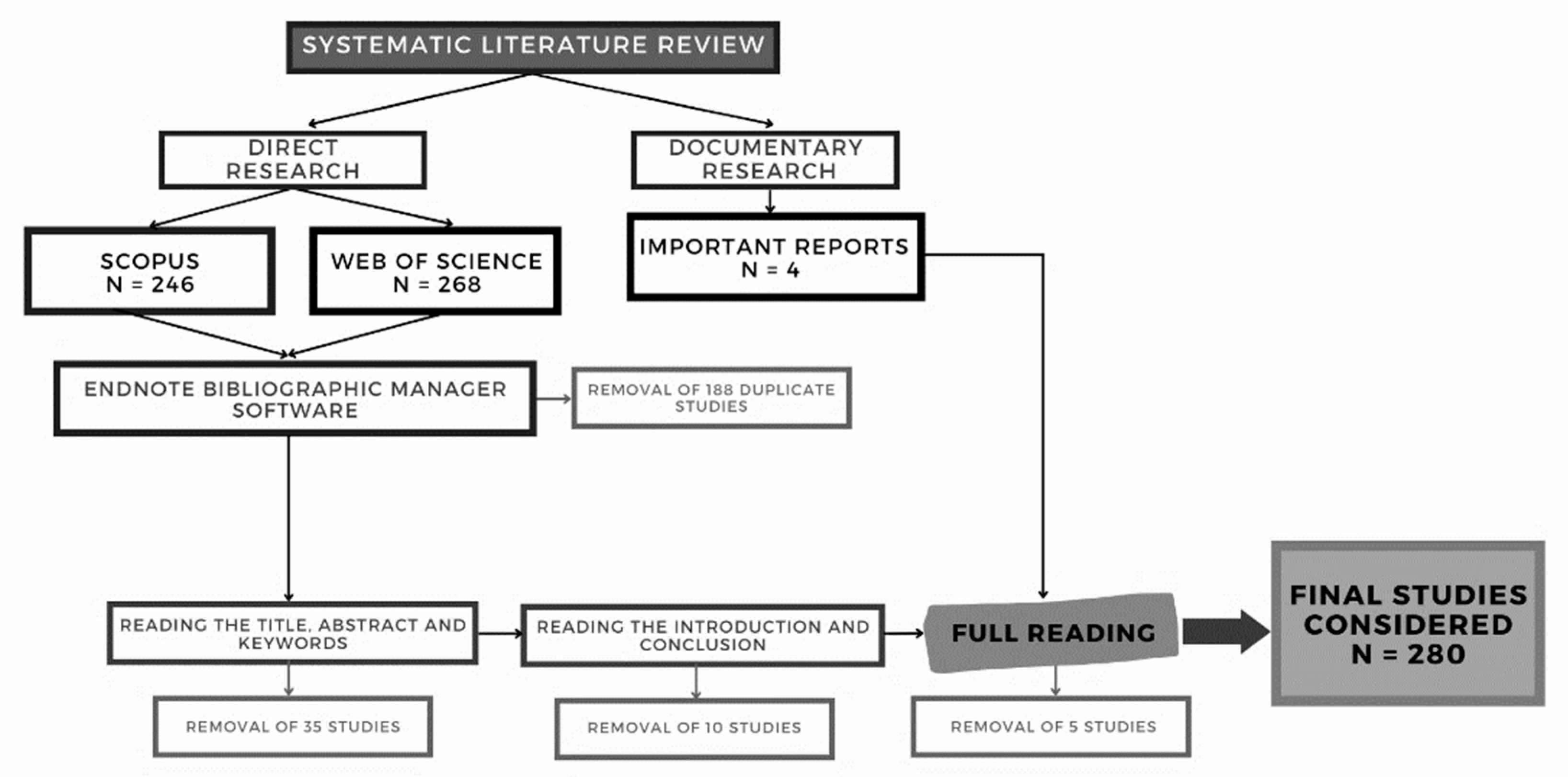
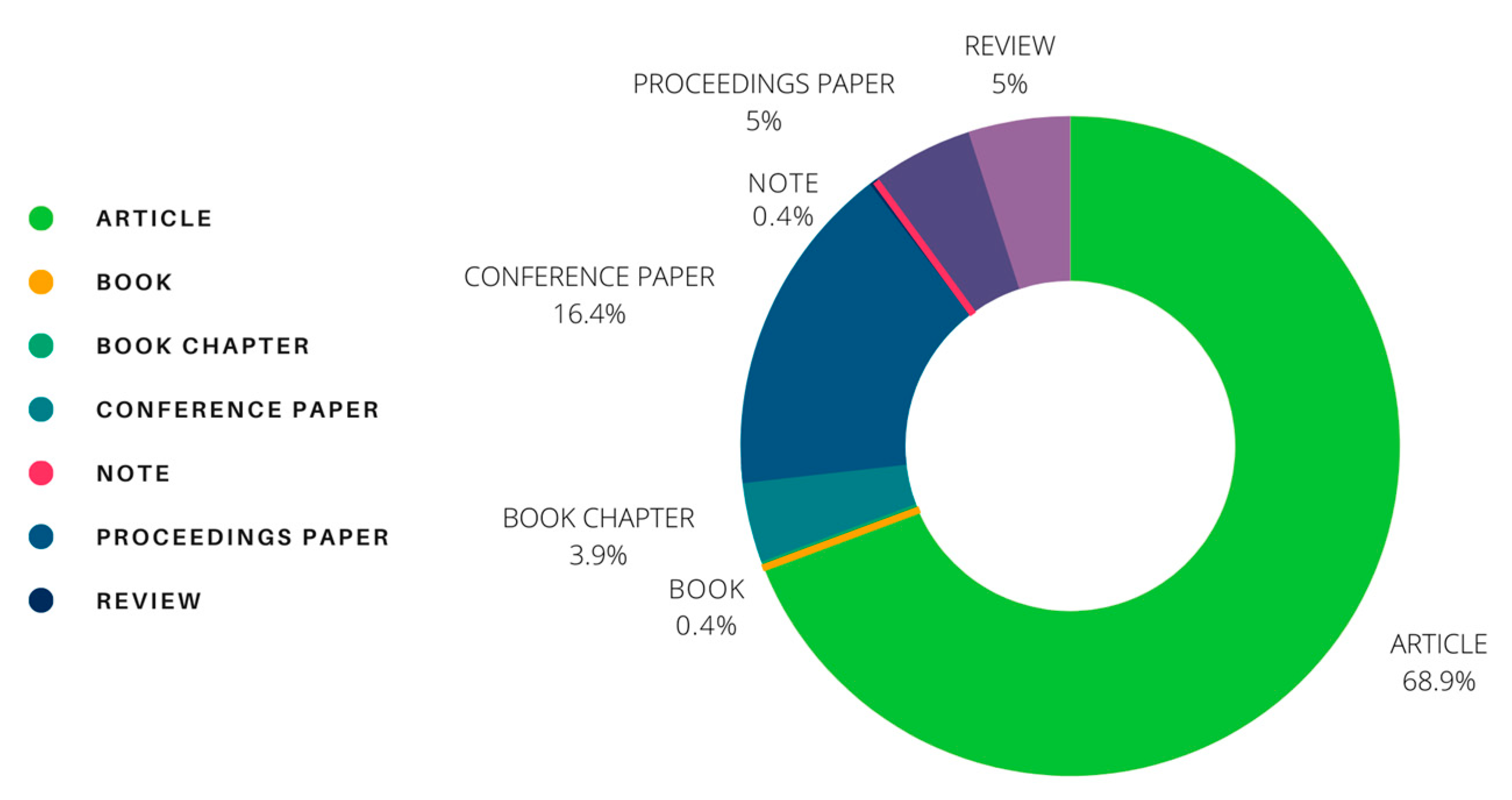
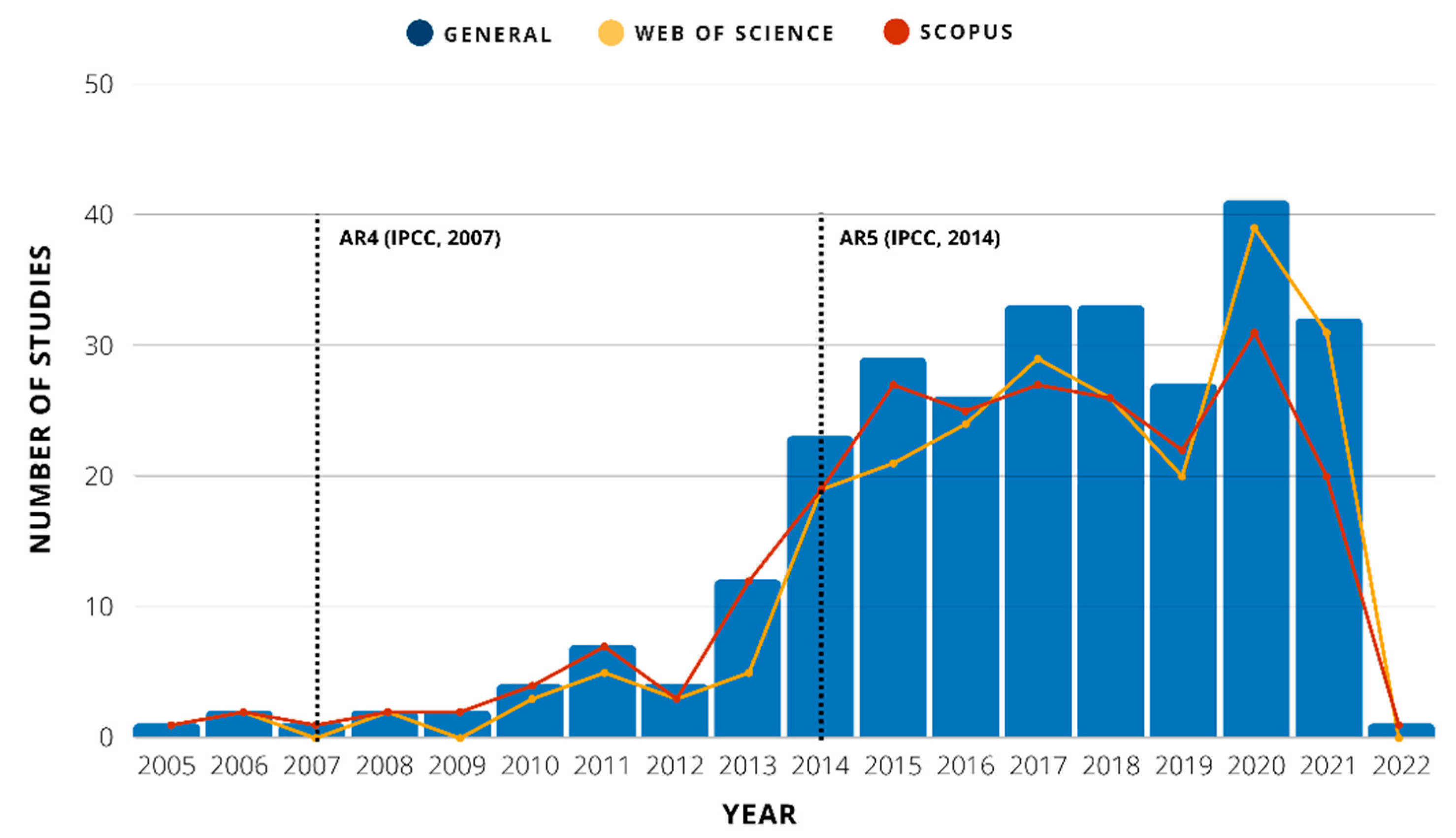
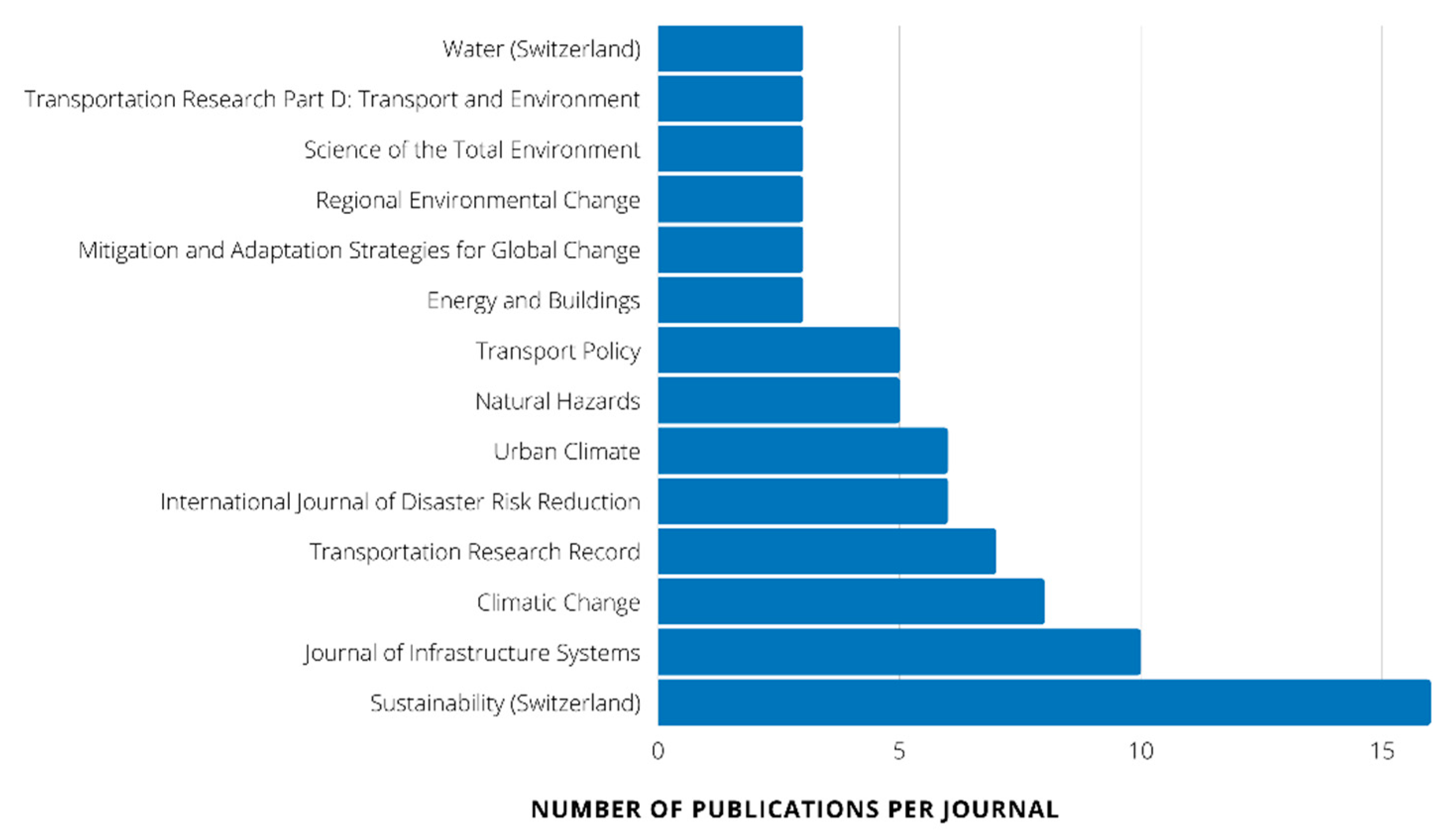

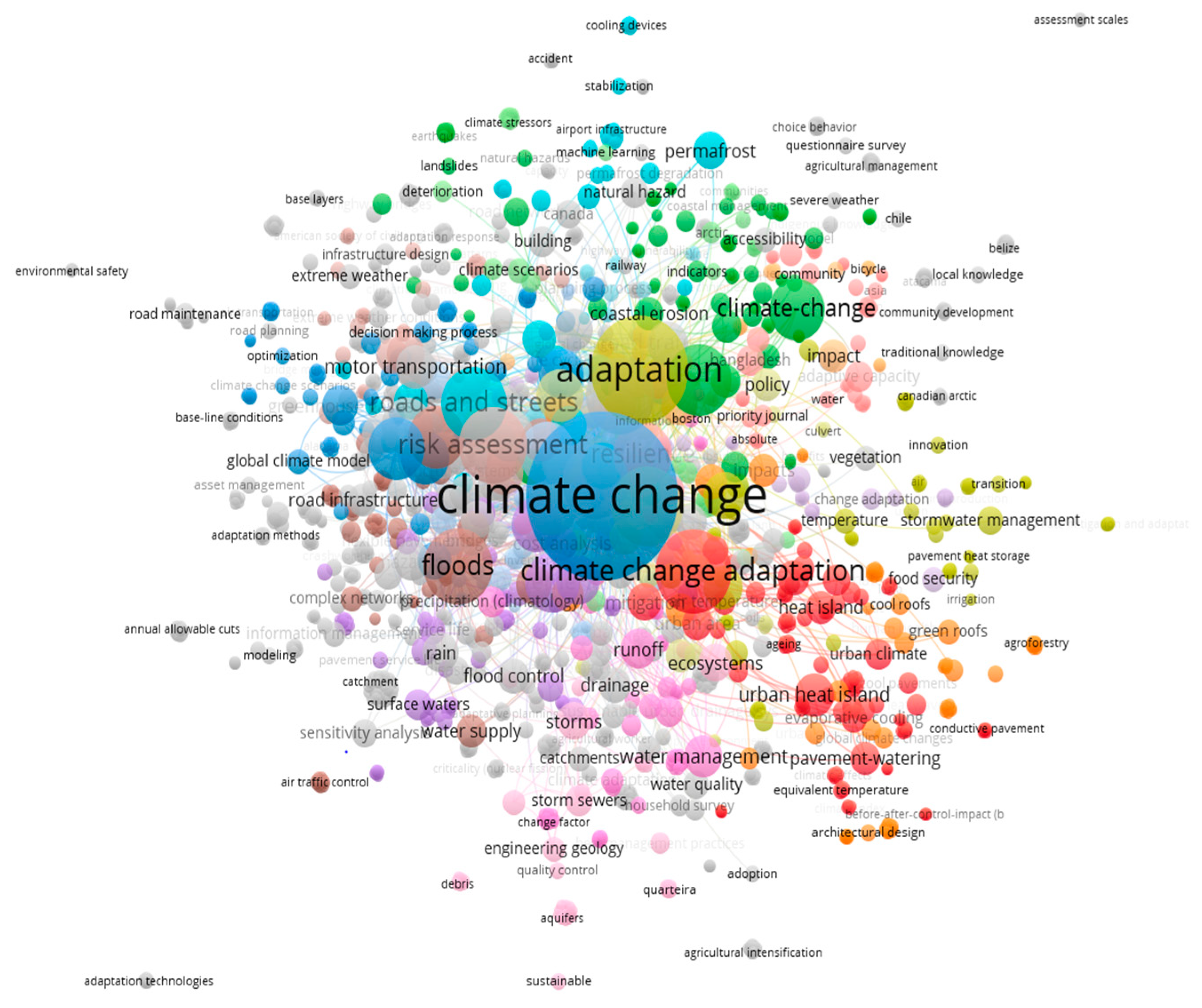
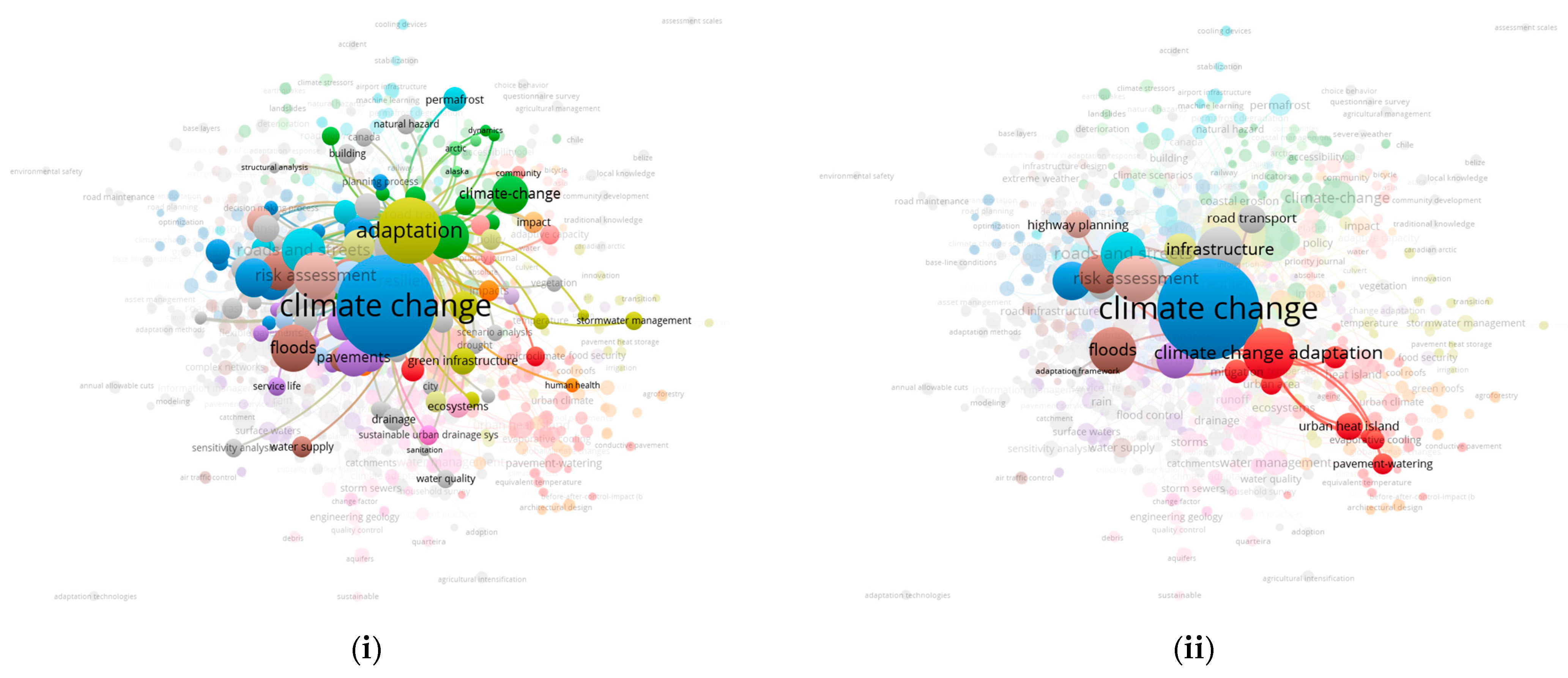
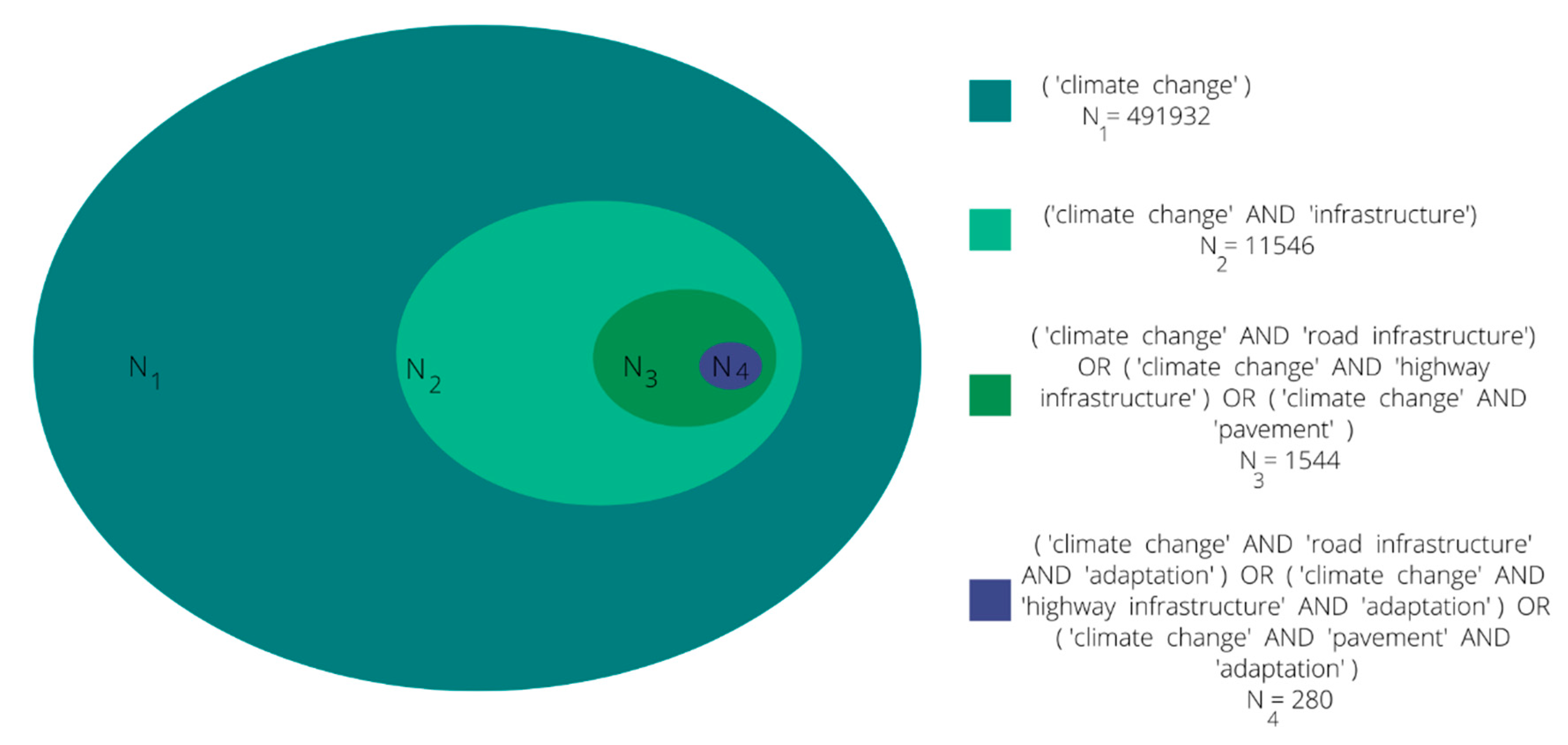
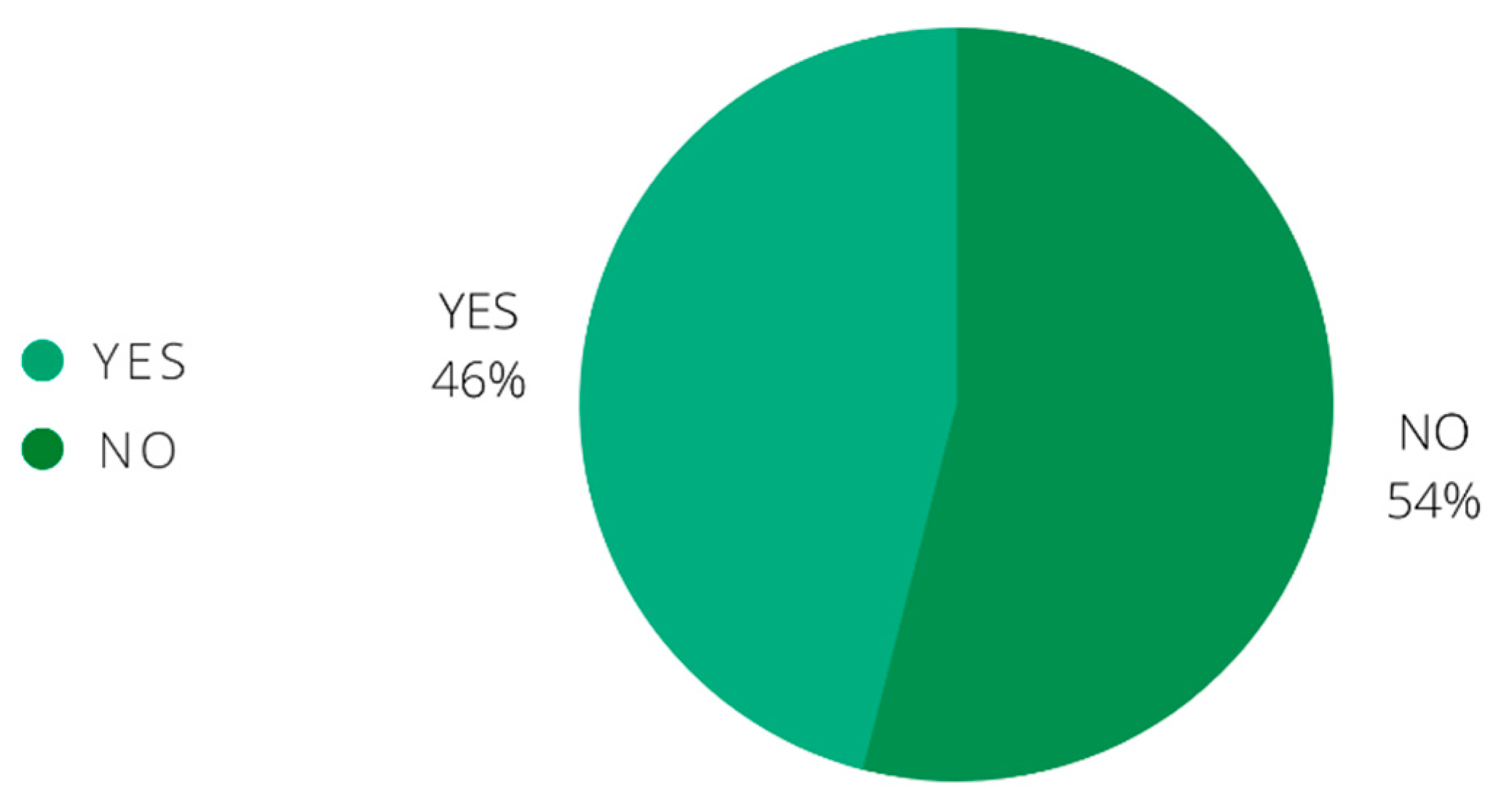
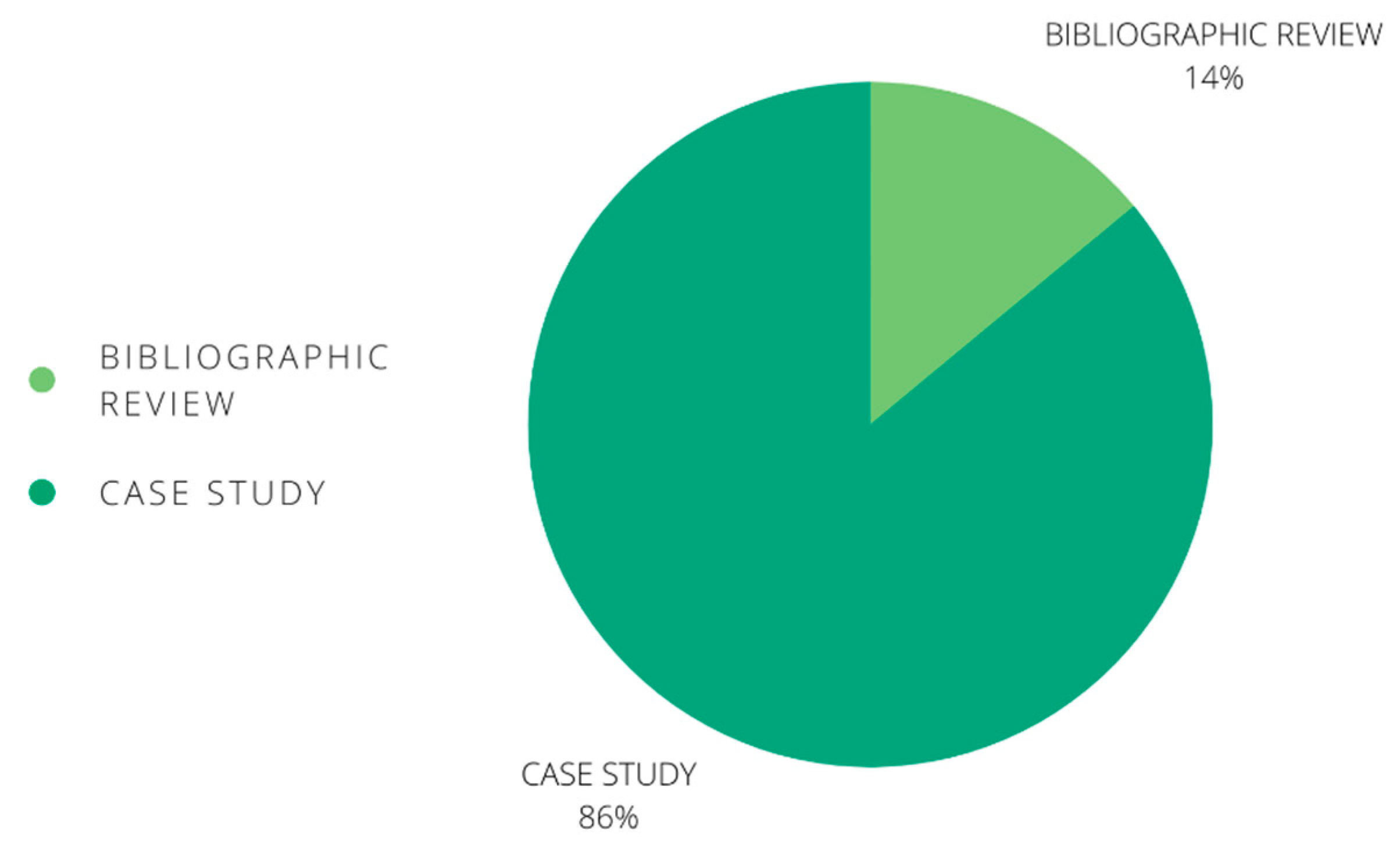
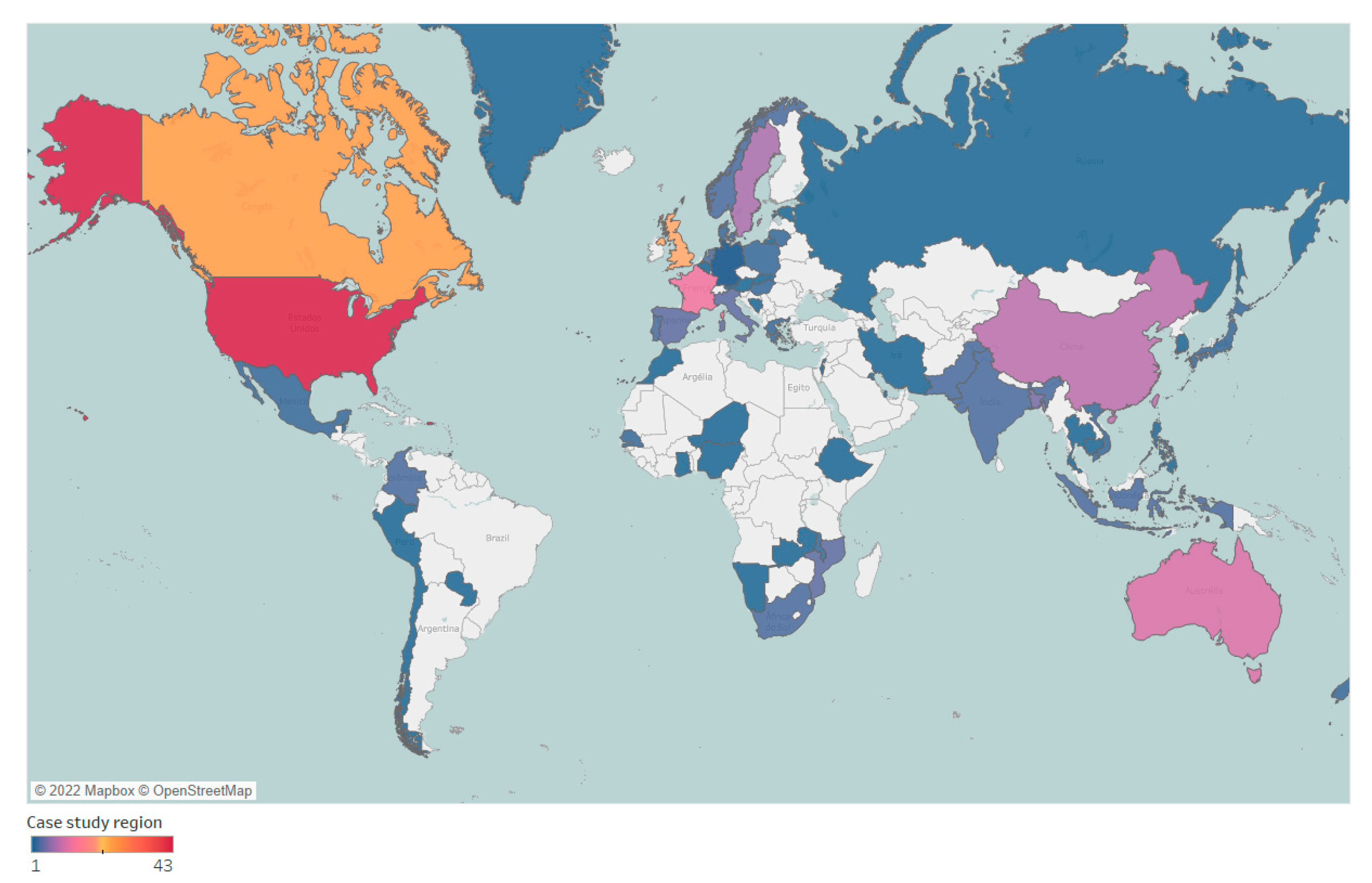

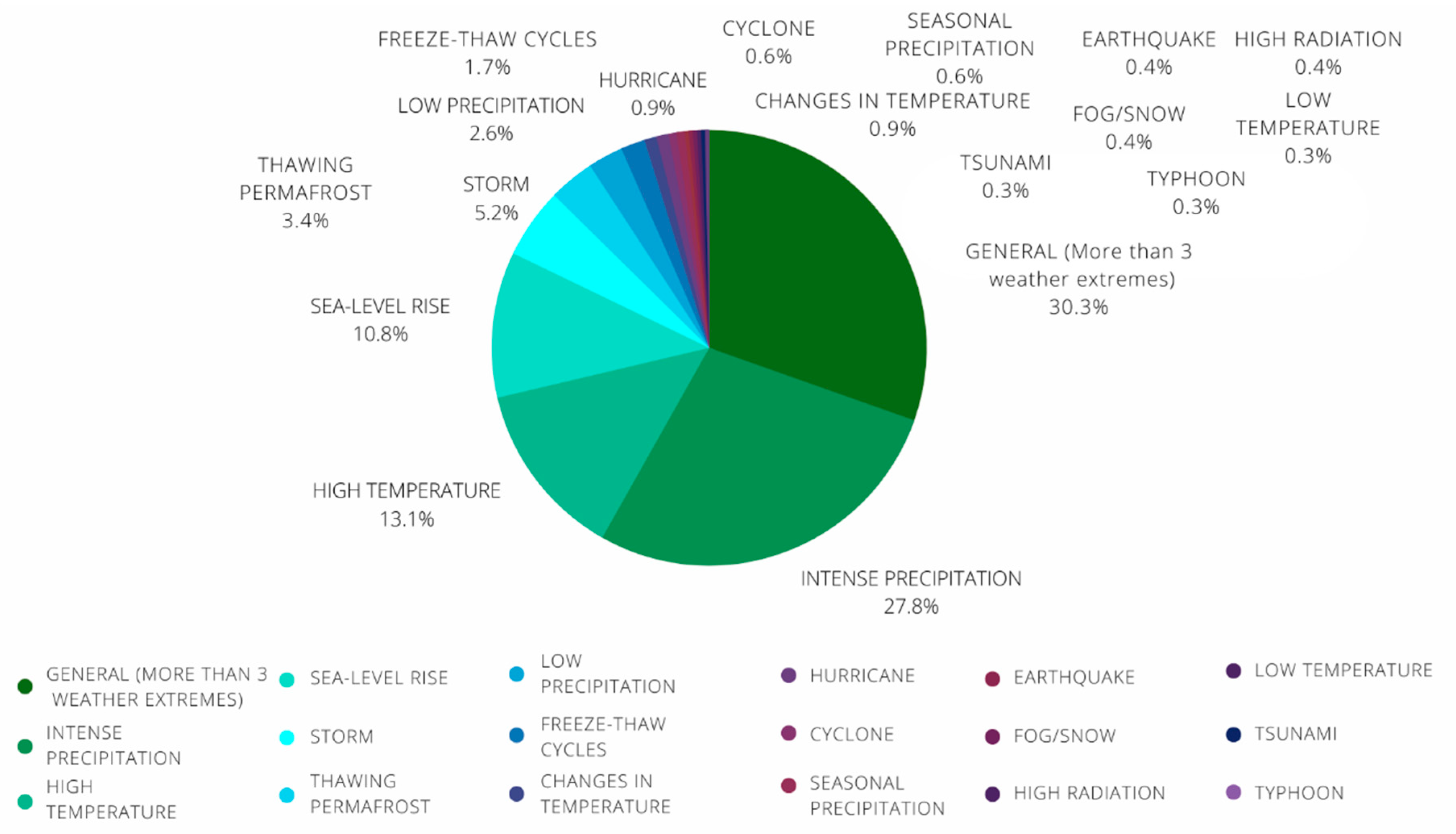

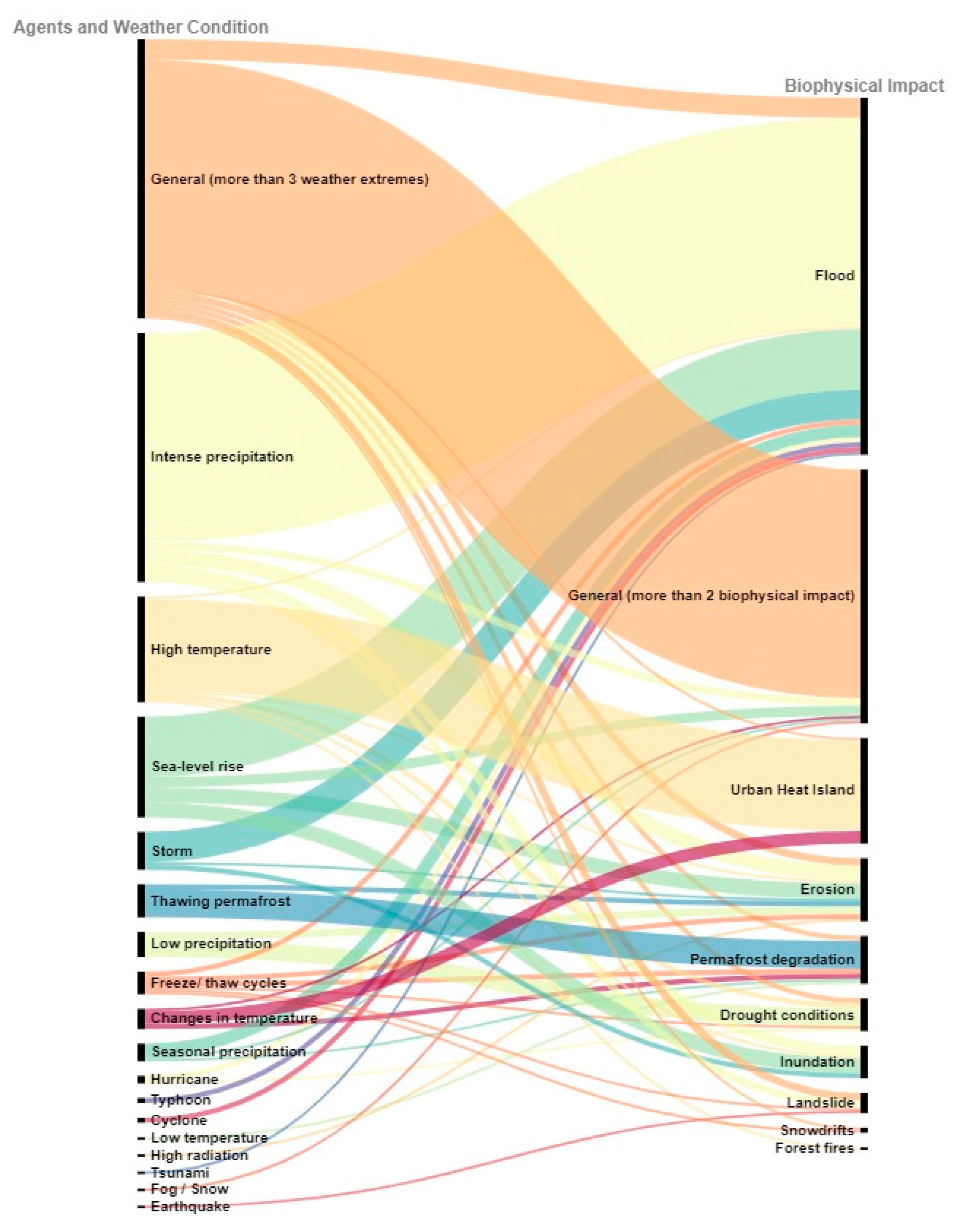
| Criterion | Description |
|---|---|
| Databases | Web of Science and Scopus |
| Topics | Web of Science-TS = (‘climate change’ AND ‘road infrastructure’ AND ‘adaptation’) OR TS = (‘climate change’ AND ‘highway infrastructure’ AND ‘adaptation’) OR TS = (‘climate change’ AND ‘pavement’ AND ‘adaptation’) Scopus-TITLE-ABS-KEY (‘climate AND change’ AND ‘road AND infrastructure’ AND ‘adaptation’) OR TITLE-ABS-KEY (‘climate AND change’ AND ‘highway AND infrastructure’ AND ‘adaptation’) OR TITLE-ABS-KEY (‘climate AND change’ AND ‘pavement’ AND ‘adaptation’) |
| Search Method | Direct Search |
| Inclusion | (I) Time of coverage: all years of the database (1945–2021), although a special focus has been given to the most current studies—the last ten years (2011–2022); (II) Source Relevance. |
| Qualification | (I) Does the study address the impacts of climate change on road infrastructure and/or the adaptation measures needed to minimize them? (II) Does the research present a well-founded literature review? (III) Does the study present technical innovation? (IV) Are contributions discussed? (V) Are limitations explicitly stated? and (VI) Are the results and conclusions consistent with the pre-established objectives? |
| Search Date | 2 January 2022, at 7:00 p.m. |
| Source Title | IF (2020) | IF (5 years) |
|---|---|---|
| Sustainability (Switzerland) | 3.251 | 3.473 |
| Journal of Infrastructure Systems | 2.411 | 3.014 |
| Climatic Change | 4.743 | 5.633 |
| Transportation Research Record | 1.56 | 1.686 |
| International Journal of Disaster Risk Reduction | 4.32 | 4.933 |
| Urban Climate | 5.731 | 5.887 |
| Natural Hazards | 3.102 | 3.656 |
| Transport Policy | 4.674 | 5.239 |
| Energy and Buildings | 5.879 | 6.175 |
| Mitigation and Adaptation Strategies for Global Change | 3.583 | 3.693 |
| Regional Environmental Change | 3.678 | 4.135 |
| Science of the Total Environment | 7.963 | 7.842 |
| Transportation Research Part D: Transport and Environment | 5.495 | 6.229 |
| Water (Switzerland) | 3.103 | 3.229 |
Publisher’s Note: MDPI stays neutral with regard to jurisdictional claims in published maps and institutional affiliations. |
© 2022 by the authors. Licensee MDPI, Basel, Switzerland. This article is an open access article distributed under the terms and conditions of the Creative Commons Attribution (CC BY) license (https://creativecommons.org/licenses/by/4.0/).
Share and Cite
de Abreu, V.H.S.; Santos, A.S.; Monteiro, T.G.M. Climate Change Impacts on the Road Transport Infrastructure: A Systematic Review on Adaptation Measures. Sustainability 2022, 14, 8864. https://doi.org/10.3390/su14148864
de Abreu VHS, Santos AS, Monteiro TGM. Climate Change Impacts on the Road Transport Infrastructure: A Systematic Review on Adaptation Measures. Sustainability. 2022; 14(14):8864. https://doi.org/10.3390/su14148864
Chicago/Turabian Stylede Abreu, Victor Hugo Souza, Andrea Souza Santos, and Thaís Guedes Máximo Monteiro. 2022. "Climate Change Impacts on the Road Transport Infrastructure: A Systematic Review on Adaptation Measures" Sustainability 14, no. 14: 8864. https://doi.org/10.3390/su14148864
APA Stylede Abreu, V. H. S., Santos, A. S., & Monteiro, T. G. M. (2022). Climate Change Impacts on the Road Transport Infrastructure: A Systematic Review on Adaptation Measures. Sustainability, 14(14), 8864. https://doi.org/10.3390/su14148864






